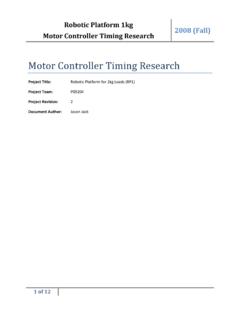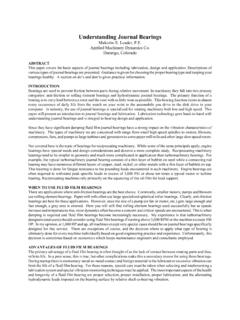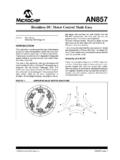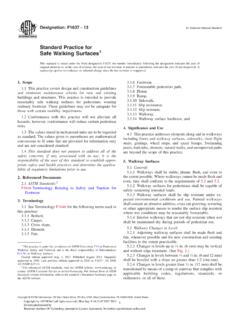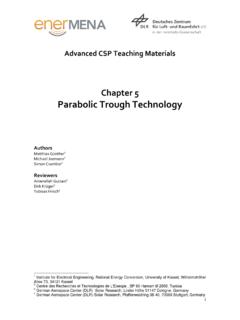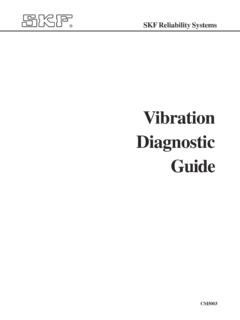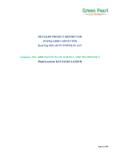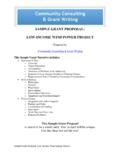Transcription of How to Prepare for a Design Review - EDGE
1 How to Prepare for a Design Review Rick Lux MSD I. October 2, 2009. Design Reviews Objectives Participants Logistics Materials for Review Optimized Review structure (time). Running the Review Actions / Issues / Decisions Documentation Examples & Templates Style Design Review Objectives Design reviews take significant time why do them? Key Objectives: Confirm Functionality, Robustness, Engineering Specifications and Customer Needs Cross-disciplinary Review Document & communicate Design approach Catch mistakes early at the Design stage Organizational & Team learning A better product done more quickly Ready, Fire, Aim The week 5 Design Review is a tollgate to starting the detailed Design We already know what we need to do.
2 Can't we bypass systems Design and jump right into the detailed Design phase? The Leverage of Good System Level Design Product Definition - Customer needs understood - Risks understood - Engineering specs defined - Alternative concepts explored - Concept selected Detail Design Verification & Testing Successful Design When is it easiest to spot Design mistakes? When is it easiest to fix Design mistakes? The Cost to Correct Mistakes $100 Easy to see but Relative hard to fix Cost to $10. Make Changes Hard to see $1 but easy to fix Concept Design Prototype Production Participants for a Successful Review Who should be included in Design reviews?
3 It will depend on the stage of development Disciplines to consider: Electrical, Mechanical, Software, Computer Manufacturing Marketing (represents Customer). Regulatory / Quality/ Safety Focus on key risks or unfamiliarity Don't hold the Review without the right participants Team owns this! Invite Alternate Points of View It could be your most senior SME. Or .. the co-op that makes a key difference Logistics Running a Successful Review What Materials should you distribute before the Review ? Agenda with times Relevant Specifications Detailed Design drawings, schematics, simulations, flow charts, test plans, etc. Known issues, discrepancies with specifications, conflicts with other disciplines Why?
4 Logistics Running a Successful Review Selecting a meeting time ( hrs minimum). may be in multiple parts held on different dates Start on time and stay on schedule Not a formal Presentation Invite discussion Focus on improving the Design avoid defensiveness & personal attacks Allocate time to the most critical areas avoid wasting time on boilerplate If you run out of time schedule a follow-up! Logistics Running a Successful Review Document Actions / Issues / Decisions Team member assigned to take notes Action items for changes, items to check, functionality changes, etc. Decisions about Design approach, specification changes, trade-offs, etc.
5 Agree on readiness to move to next phase before leaving meeting Update Edge with copies of materials Typical Design Review Agenda (Week 5). Your expectations for the Design Review Project background or introduction Problem to solve or key project objective(s). Team member roles and responsibilities Critical customer needs and associated engineering specs Concept selection process Systems architecture to realize selected concept Functional architecture with key subsystems Physical architecture showing functional elements Validation of engineering specs Feasibility analysis / engineering or technology analysis Issues, challenges, risks with mitigation plans.
6 Next steps and updated schedule for rest of quarter See Examples Project Background Xerographic digital printers are very energy intensive, specifically the fusing sub-system. This is largely due to the fact that during the fusing process toner is heated to well above its melting point, to enable heat flow, and allow the toner to adhere to the paper. Senior Design Project as Stated on Edge: Re-consider the Design of an extremely low power, non-thermal fusing system . Example from Low Energy Printing Project P09505. January 16, 2009 Senior Design I - System Level Design Review 15. Project Scope The purpose of this project is develop a fusing sub-system that uses pressure instead of thermal energy to fuse toner to paper.
7 The new Design should fit into the current Xerox Workcentre 245/55 Pro printer, however if due to Design constraints the new Design in unable to be fit internally it my be externally attached to the Xerox Workcentre 245/55 Pro printer. Example from Low Energy Printing Project P09505. January 16, 2009 Senior Design I - System Level Design Review 16. How a Fusing Sub-System Works Heat Traditional Toner Fusion: Discrete, loose Fused, adhered toner toner Temperature +. Pressure +. Heat =. Pressure Fused, Adhered Toner Image by: David Thompson, Xerox Corp. Information by: David Thompson, Xerox Corp. and Dinesh Tyagi, Eastman Kodak Company Example from Low Energy Printing Project P09505.
8 January 16, 2009 Senior Design I - System Level Design Review 17. Customer Requirements Number: Need Type: Need: Customer Weight 1 Paper is not damage 9. 2 Print Quality Image be Xerox quality 3. 3 Print has a low gloss 1. 4 Fit into current Xerox Workcentre 245/55 Pro 3. 5 Use pressure only to fuse toner to paper 9. Compatibality 6 Accept paper in orientation it currently enters fuser (SHF / LHF) 3. 7 Compatible with other Xerox models (prefered color printer of same size) 1. 8 Sub system cost less then current system 3. Cost 9 Easy of manufacturing 3. 10 User must be able to safely clear jam in fuser 9. 11 Low Energy non thermal 9. 12 Misc.
9 Technology can be used up and down along Xerox stream 1. 13 Fuser last life of product (roughly 3 million prints) at least 100,000 prints 1. 14 Standard office grade paper (20/24 pound paper) 9. 3 Most Important Customer Requirements: Paper is not damaged Fit into current Xerox Workcentre 245/55 Pro Use pressure only to fuse toner to paper Example from Low Energy Printing Project P09505. January 16, 2009 Senior Design I - System Level Design Review 18. Engineering Metrics Engineering Metrics Technical Targets Measurements Techanical Targets Paper Curl Deflection of Paper < ". Paper Damage Change in Paper Thickness % Change < 50%. Cost Dollars < $ Adhesion of Toner to Paper Change in Optical Density Cohesion of Toner to Paper Change in Optical Density Speed of Process Pages per Minute 35 pages/minute Amount of Smearing Change in Optical Density Heat Produced by Process Celsius < 50C.
10 Uniform Half Tone Change in Optical Density Reflectivity Std. Gloss Meter Length of System Inches 12". Width of System Inches 5". Height of System Inches 5". Weight of System Kilograms Utility of Cost Incurred by Customer Watts/hr Size of Paper Accepted by System Inches 11" x 11". Number of Parts N/A current Ability to Release Pressure Newtons Accident Incidences Reported Injuries < 100/year # of Prints Before Failure N/A 100,000 prints Durability of Fix Weeks At least 1 week Compatibility w/Xerox Manu. Proc. Example from Low Energy Printing Project P09505. January 16, 2009 Senior Design I - System Level Design Review 19. QFD - Correlation Matrix Engineering Metrics Compatibility w/Xerox Manu.
